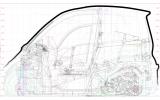Oil giant Shell has revealed further details of the city car concept it has built in conjunction with Gordon Murray and former Honda F1 engine designer Osamu Goto. The three-seat vehicle is expected to weigh less than 600kg and offer fuel economy of more than 100mpg when measured on the official European cycle.
Project M, as the concept is known, is a 1+2 car design that aims to inspire fresh ideas on simple global cars for congested urban areas. The car has its roots in Murray’s new-era T25 urban car, first revealed in 2010, which underwent a “complete rethink from the ground up” for this new project with Shell and Goto’s Geo Technology engine laboratory.
The concept represents a fightback for fossil fuel vehicles in an era that has tended to favour hybrids and electric cars. The partners describe it as “an ultra-compact, efficient car for city use, based around the internal combustion engine”.
The engine is a three-cylinder, 660cc Mitsubishi-derived unit used in the original T25, albeit thoroughly overhauled by Goto’s Geo Technology company. The development of Project M’s engine, lubricants and vehicle were completely integrated from the outset.
The project marks the first time Geo Technology has worked on a passenger car, and the company brought to bear its experience in reducing friction in motor racing engines.
Due to the light weight and comparatively low drag of the Murray chassis, Geo Technology deemed the engine’s standard performance to be more than sufficient for the car’s requirements, so it reduced the engine speed of the base unit, which in turn helped to minimise internal friction.
The engine now produces about 47bhp at 5500rpm and the car is capable of a top speed of just over 70mph.
Detail changes to the engine include a friction-busting diamond-like coating (DLC) which was applied to the camshaft, tappets and piston skirts.
“The lubrication between camshaft and tappets is one of the most critical parts of the engine,” said Geo Technology’s director of engineering, Hidehito Ikebe. “To reduce friction, it is usually only necessary to coat one, but we applied it to both.”
To take into account the reduction in engine speed, the design of the retainer and valve springs were changed and titanium valves were installed. A new piston was designed, retaining only the original piston crown, which is important for the combustion process.
The piston skirt was shortened by 30% compared with the base engine and the contact surface with the cylinder was reduced by 40%. The recesses on the piston skirt which normally retain the lubricant were removed in favour of a polished contact surface of the skirt and the DLC coating.









Join the debate
Add your comment
.
My 2010 Ford Focus TDCi gets
It's got five seats plus good baggage capacity, so I'm not so impressed by this Smart lookalike's 100mpg performance.
As for styling, the GM has some way to go, so I won't be unkind.
What did I miss?
And that was a proper quality car not something resembling the illegitimate love child of a smart and a twizy....